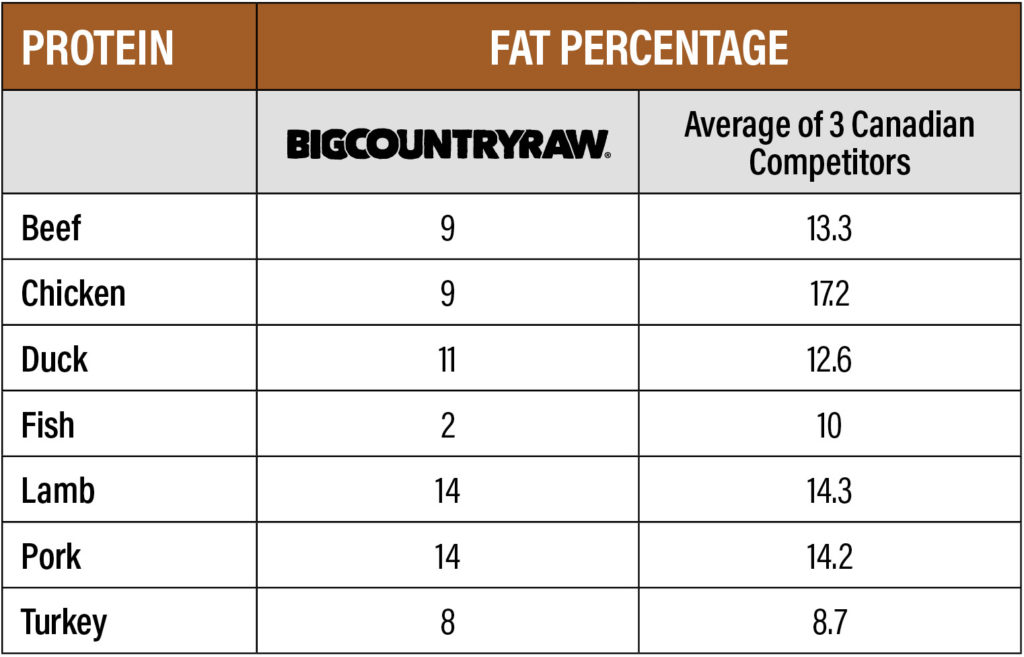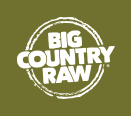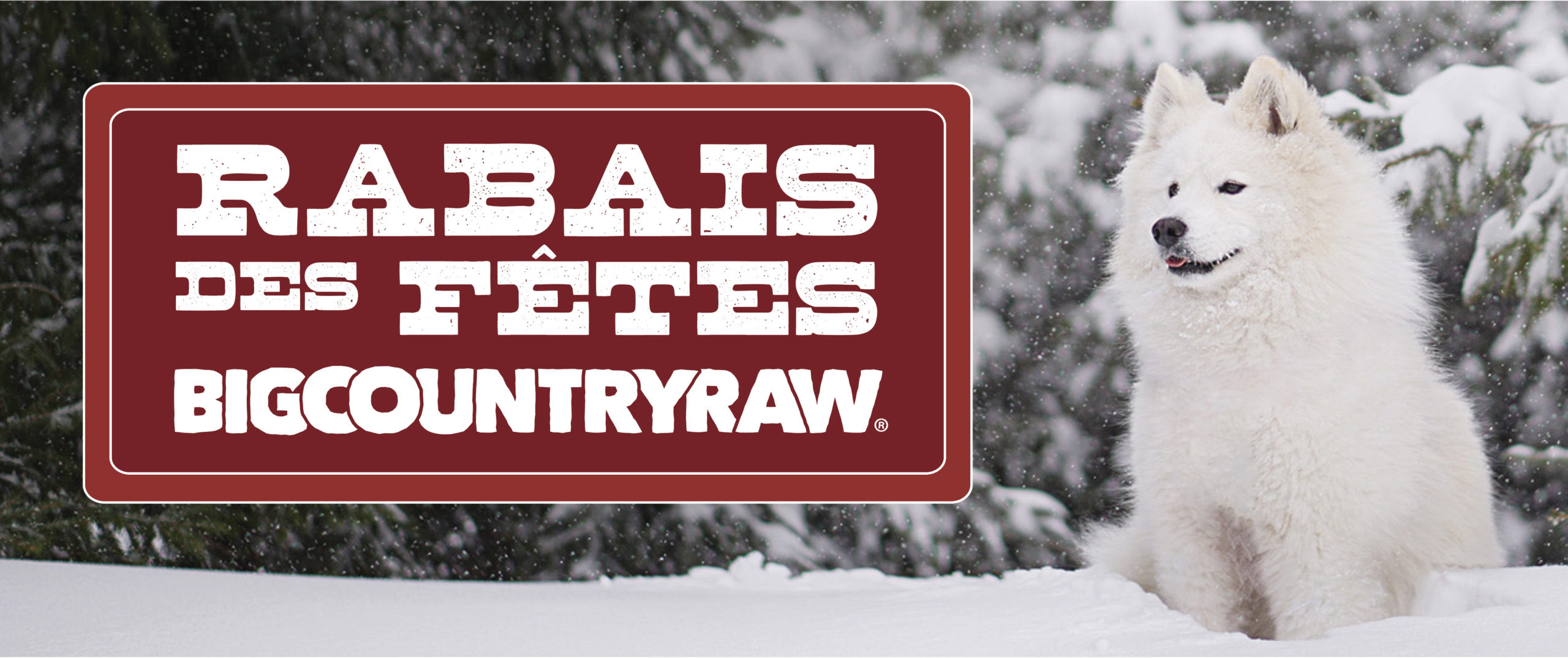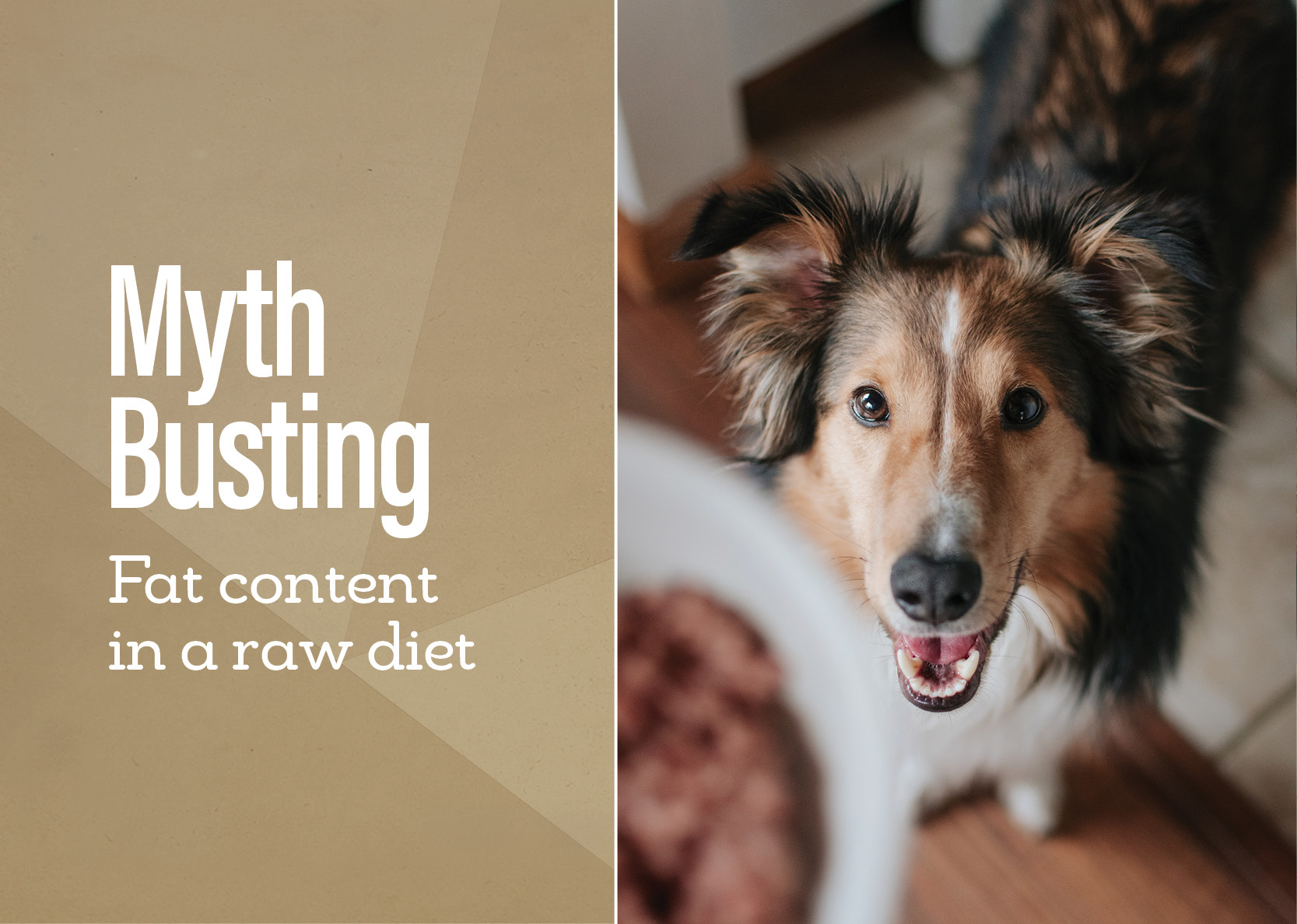There’s a lot of buzz lately surrounding the fat content of raw diets. We’d like to separate the facts from fiction to help our customers, and other raw feeders, feel confident in their choice to feed a species appropriate raw diet to their domestic carnivores. We like to think of our pets as family and sometimes this can be detrimental because in a lot of ways, they’re not like us.
Myth #1 – Dogs, like people, need a low-fat diet
This is simply not the case. Unless your pet is severely overweight or has a medical reason to limit their fat intake, like suffering from pancreatitis, feeding a low-fat diet is not necessary for our pets. Both carbohydrates and fat are energy sources for our pet carnivores. Feeding a fresh food, raw diet that’s lacking in carbohydrates, means that your pet will derive the energy they need for growth and play from fat. Biologically, they are designed to eat this way – from the sharp teeth used to ripping and tearing meat and lack of molars to crush and grind carbohydrates, to producing very little amylase, the enzyme that breaks down carbohydrates.
Low fat diets fed for long periods of time can actually have some serious negative health consequences. Most noticeably dry skin, coat and nails, hair loss, poor muscle tone, and more severely, continued weight gain, a diminished immune system, and other, more serious health problems such as heart disease and diabetes. Our pet’s energy has to come from somewhere, and low-fat diets substitute carbohydrates which break down into sugars which then can lead to diabetes. Fun fact – diabetes is NEVER found in wild carnivores – only in domesticated pets fed a high carbohydrate diet.
In addition to being a source of energy, fat is also essential for the absorption of fat-soluble nutrients, such as essential vitamins D and E. A diet low in fat can impact absorption of these vitamins, causing deficiency.
If you’re not feeding a high carbohydrate diet, and also greatly limiting fat, your dog can get it’s required energy from their body’s protein reserve, essentially robbing their muscles of the protein they need to work effectively as a source of energy – not an ideal situation. A diet like this can easily lead to muscle injury, especially in very active dogs that rely on muscle mass.
If your dog does need a lower fat diet because of IBD or pancreatitis, healthy omega-3 fats and poly-unsaturated fatty acids don’t require as much bile acid and pancreatic enzymes to be digested properly, if at all. They are almost all directly absorbed through the blood system, making them great healthy fat additions to the food bowl.
Myth #2 – Feeding less than the recommended portion of food will certainly cause nutrient deficiencies.
The main reason that someone might choose to feed less than the recommended portion of food is that their dog either gains weight too easily or needs to lose weight. The tendency in dogs to carry extra pounds can be dependent on their breed or genetics but that is only half of the equation. Activity level also plays a huge role. Most dogs today are highly inactive because in fact, for most dogs, a half hour walk twice a day should be considered very minimal exercise.
As dogs age, however, the desire and ability to be active sometimes decreases and this means lowering their daily calorie intake to keep them at a healthy weight. A common adage is “feed the dog in front of you” – meaning that every dog is unique in what their body needs. Whether you’re feeding kibble or raw, the simplest ways to maintain a healthy weight is to increase activity and reduce food in the bowl and if you’re offering a lot of treats, reduce or eliminate those as well.
When fed a Big Country Raw diet at 80% of the suggested portion, the vitamin and mineral deficiencies in Big Country Raw Dinner formulations are very minimal, and when fed in rotation as Big Country Raw always suggests, are virtually non-existent. Many dogs do not eat the “recommended” amount for their weight whether raw or kibble fed so they would also be deficient based on these claims.
Knowing that the amount of food a dog might eat can vary greatly, Big Country Raw Dinners are balanced based on the calorie content of the food, not the amount of food, which takes into account that higher fat proteins require less food in the bowl. Because of this, we’ve balanced each calorie to meet the minimum requirement.
To give a better idea of how this works:
– To get 100 calories from Fish Dinner, you would feed 105g
– To get 100 calories from Lamb Dinner, you would feed 51.3g
So if dogs eat based on their calorie requirement, which can vary based on age, breed, activity level and other factors, they will get the nutrients they need because we balance each calorie and not amount of food fed.
Myth #3 – Feeding high fat will make my dog fat
Dogs and cats don’t store carbs, they are either used as they are absorbed if there is a need. If there is no immediate energy need, the carbohydrates (ultimately glucose) can only be stored in the form of fat – and always unhealthy, saturated fat.
In actual fact, studies show that high carb diets contribute to obesity more readily than high fat, high protein diets. For the same amount of caloric intake (4kcal/g for both protein and carbs), a diet higher in carbs causes more weight gain than a diet higher in protein. A dog’s body can break down fat and protein into glucose for energy. But carbohydrates have only one use; immediate energy, or the unhealthy alternative, storage as fat.
Myth #4 – A balanced diet is balanced for all dogs
It’s well known that certain breeds of dogs and cats have predispositions to certain health concerns. For example, Dalmatians are prone to urinary stones and therefore are suggested to eat a low purine diet, and some terrier breeds are prone to chronic renal failure so require a high-quality protein diet. Diets formulated to meet breed specific concerns can reduce the risk of a disease presenting as well as reduce its intensity and frequency. This is just a small example of how a one diet fits all approach is not the best one.
The good news is, for dogs with specific dietary needs, we’ve done the bulk of the work – formulated our Dinner and Fare Game recipes to meet the NRC guidelines verified through third party laboratory testing but with some small tweaks, our diets can meet the specific dietary needs of almost every dog. Big Country Raw uses the NRC guidelines because their recommendations are based on scientific research which takes into account bioavailability of the ingredients being used to formulate diets. Bioavailability of nutrients can vary up to 80% depending on the form of the specific vitamin or mineral which could easily lead to toxicity if not accounted for.
It’s important to note that there is absolutely no diet that can be made commercially or even by a trained nutritionist for one specific pet that is 100% balanced for every pet because of what is unknown about the absorption of each vitamin and mineral by each individual pet. Offering a diet that we know to be balanced for the “average” animal within a species is an industry accepted method for determining nutrient requirements.
Myth #5 – If your diet is balanced, variety is not important
Big Country Raw offers 12 different protein options and blends that contain their unique nutritional profile. If a lower fat diet is necessary for your pet, this is achievable by simply offering a protein rotational diet. Replacing as little as 25% of any dinner formulation with Fish Dinner, Quail Dinner or Pure Salmon reduces the fat content by more than 20%. Or if you’re looking for less calcium in the diet, feeding half red meats and half poultry proteins, balances out the calcium nearer to a 1.2:1 ideal ratio.
It’s always a good idea to make routine veterinary wellness visits so your dog’s vet can monitor for any signs of vitamin or mineral deficiency. This wellness exam can and should occasionally include a blood panel that can indicate any signs of being unwell before they become more severe.
Aside from the nutritional benefits of protein rotation, your pet will also be more interested in mealtimes, be less picky, and have a lesser chance of developing food allergies or intolerances later on.
Myth #6 – Big Country Raw is higher fat than other Canadian raw pet food
We’ve compared the published fat content of several Canadian raw pet food manufacturers and though the fat content percentages are varied from brand to brand, it’s proven that Big Country Raw diets are well within the average for fat content.

In Summary…
Fat plays an important role in your pet’s diet, and doesn’t necessarily cause your pet to be obese. Some dogs don’t fit into the “average” and require a tweaked recipe for optimal health. We should feed our pets the same way we feed ourselves. The Canadian Food Guide states that the “average” human requires 2000 calories daily, but individual needs may vary. So how do most humans feed themselves? One human might simply, because of their age, size, or activity level, eat only 1400 calories a day or would gain weight which is unhealthy. These people that consume less calories daily most often don’t balance each meal scientifically but take a more relaxed, natural approach to their health. They try to eat balanced meals, using all the food groups, limiting junk food that provides little nutrition. Like a veterinarian would for a dog, they might get regular check-ups by their doctor to ensure that there are no signs of vitamin or mineral deficiency – and in most cases this works.
All pet parents do their best to ensure that their furry family members are getting the best, balanced nutrition but there will always remain an element of unknown surrounding bioavailability or absorption of vitamins and minerals for each dog or cat. No matter your pet’s diet, routine veterinary health and wellness examinations are a great way to catch any possible deficiencies (or excesses) early.
Here at Big Country Raw, we truly believe that our dogs do eat better than us. The vast variety and quality of ingredients, the recipes we’ve formulated using nutritiously dense bones, meat, and organs, with no fillers, or ingredients that do not contribute to the overall health of the pet. The majority of pet owners cannot truthfully say that they choose the food they eat so carefully.


